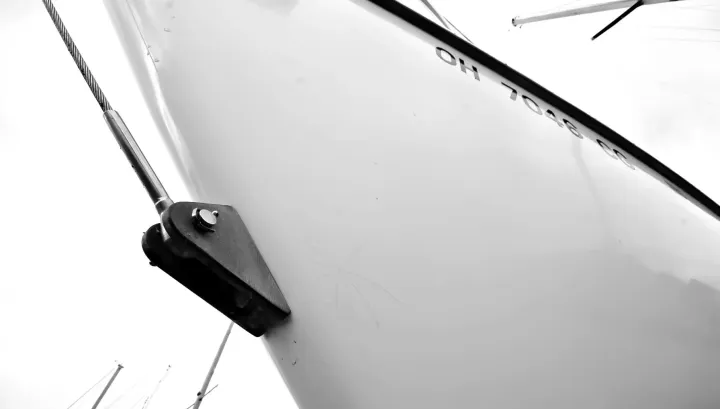Do you ever wonder what exactly a lazy jack is and how it can help you sail better? If so, we’ve got all the answers you need.
Are you struggling with hauling down the mainsail? Or want to make difficult weather conditions a little more manageable?
If so, we're here to teach you everything you need to know about using a lazy jack. Basically, all you need to use a lazy jack is a line, rope thimbles or blocks, some pad eyes, and some basic sailing knowledge.
Within this article, we will cover the following:
- What is a lazy jack?
- How do you use a lazy jack?
- Using a lazy jack to hoist the mainsail
- Reasons to get a lazy jack
- How much does a lazy jack cost?
- Downsides of lazy jacks
What is a Lazy Jack?
Simply, a lazy jack is a type of rig which can make lowering or raising the mainsail easier.
Lazy jacks are basically webs of lines which run between the mast and the boom, preventing the lowered sail from falling onto the deck. Of course, the exact look of the lazy jack will depend on the ship construction and the budget.
One main benefit of using a lazy jack is that it can help you to save time, navigate better, and can stop you from fighting so much with your mainsail. You should note, however, that they should never take the full weight of the sake and boom - instead, they should just keep the sail and the stack centered.
Now, onto one of the most important parts: how do you use a lazy jack?
How Do You Use a Lazy Jack?
Lazy jacks are very simple to use. Simply, you will need to rig the line networks along each side of the mainsail from several points on the boom, or you can use a stack pack at around 60% of the mast's height.
Generally, you will take the lines called 'legs' and join them with the single lines which are called 'risers', coming together to form two upside-down Y shapes.
However, there are various other ways of rigging the lazy jack legs, depending on personal preference and what you are planning to do. For example, you can join the legs to the risers with rings or blocks, or even tie them together. This then creates a space between the two lazy jack sets which is known as the 'pocket'.
Using a stack pack can make things a little easier, as this modern type of sail cover is attached to the boom and can then zip closed, protecting the sail when it's not in use. When you use a lazy jack with a stack pack, you should tie them to the stack pack in order to help support it.
Using a Lazy Jack to Hoist the Mainsail
Specifically, you are going to want to follow the upcoming instructions to properly use a lazy jack:
- Keep the boat steady with the bow facing the wind
- Begin to loosen the mainsheet and then hoist the mainsail
- When the legs join the risers, you're going to want to keep an eye on the sail. You should watch to make sure that it doesn't snag, and if the wind pushes the sail towards one of the legs, you should steer towards the wind. Once the sail is luffing evenly in the pocket, you can continue.
- If a batten gets snagged, you will need to immediately stop hoisting. Then, lower the sail until the line is clear of the batten, and steer toward the wind until the sail has been pushed back into the pocket
Reasons to Get a Lazy Jack
There are plenty of reasons why you might considering purchasing a lazy jack, one of the most simple being that it just makes things a little easier.
A lazy jack can help you to save time and hassle, especially when you find yourself in unfavorable weather conditions whilst trying to keep a steady course. If there's dense traffic, wind, or the sail is a struggle to keep under control, then you're going to wish that you had a lazy jack.
Especially for solo sailors, a lazy jack can be a lifesaver. It can help you to navigate out of a dangerous situation faster and can give you the space to focus on steering the boat safely.
Not to mention that getting a lazy jack doesn't have to be a complicated affair - they can be just as basic or as advanced as you like. The most simple lazy jack will just need a line, pad eyes, and some blocks or rope thimbles.
How Much Does a Lazy Jack Cost?
The price of a lazy jack depends on two main factors: whether you will be purchasing a commercial lazy jack or simply making one yourself.
Whilst commercial lazy jacks come with pre-packaged ease, they can also come with a hefty price tag. If your sailboat is on the larger side than one of these kits could easily cost thousands of dollars - and then you'd still need to pay someone else to install it.
The DIY lazy jack method, along with being cheap (usually less than 50 dollars), can also be quite simple. There are plenty of information guides online which go into detail on how exactly to build your own lazy jacks, and some marine companies will even give you step-by-step guides. We recommend this one.
Downsides of Lazy Jacks
There are very few downsides of getting a lazy jack, although there are some potential issues that you should be aware of before installing one.
One of the most common issues with lazy jacks is that sometimes, when you raise your mainsail then the lazy jack can get in the way. However, this is very simple to fix: all you need to do is either use caution when steering or lash up a low-friction ring to angle the lazy jack away from the mast.
Along with that, the stack pack could add windage which affects sailing performance, but casual sailors shouldn't need to worry too much about this.
In general, however, a lazy jack can be a great addition to your sailboat, helping you to navigate the world's waters with ease.



